Papua New Guinea
On Rough Seas - Vanimo to AitapeOn Rough Seas – Vanimo to Aitape
One of the great things about crossing PNG’s only land border, from Jayapura in West Papua, is that the first stop is the little seaside town of Vanimo. It’s safe, pretty, and populated by friendly locals; a gentle introduction to PNG compared to some of the rougher cities further along the coast.
The bus from the border dropped me at the Vanimo Beach Hotel and, after finding that they charge 270 kina (€71.94/$79.38) a night, I very quickly decided to get creative. I’d read that there was a church guest house somewhere in Vanimo, so I went and knocked on the door of the first church I came across and asked the nun who opened it. She sent me to the priest next door, who confirmed the existence of the guest house, which was 160 kina (€42.63/$47.04) a night and a couple of kilometers out of town. Slightly better, but still way outside my usual budget, and anyway I’d heard that local Papua New Guineans are very happy to host strangers in their homes and I was eager to test the theory.
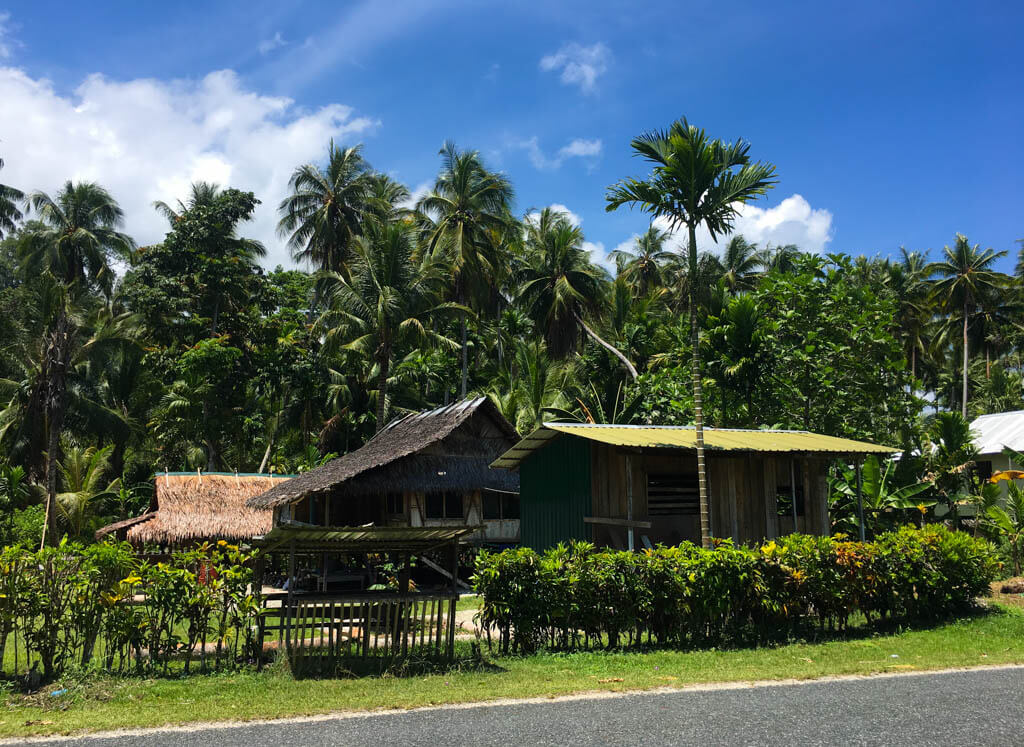
The road to Vanimo from the Indonesian border
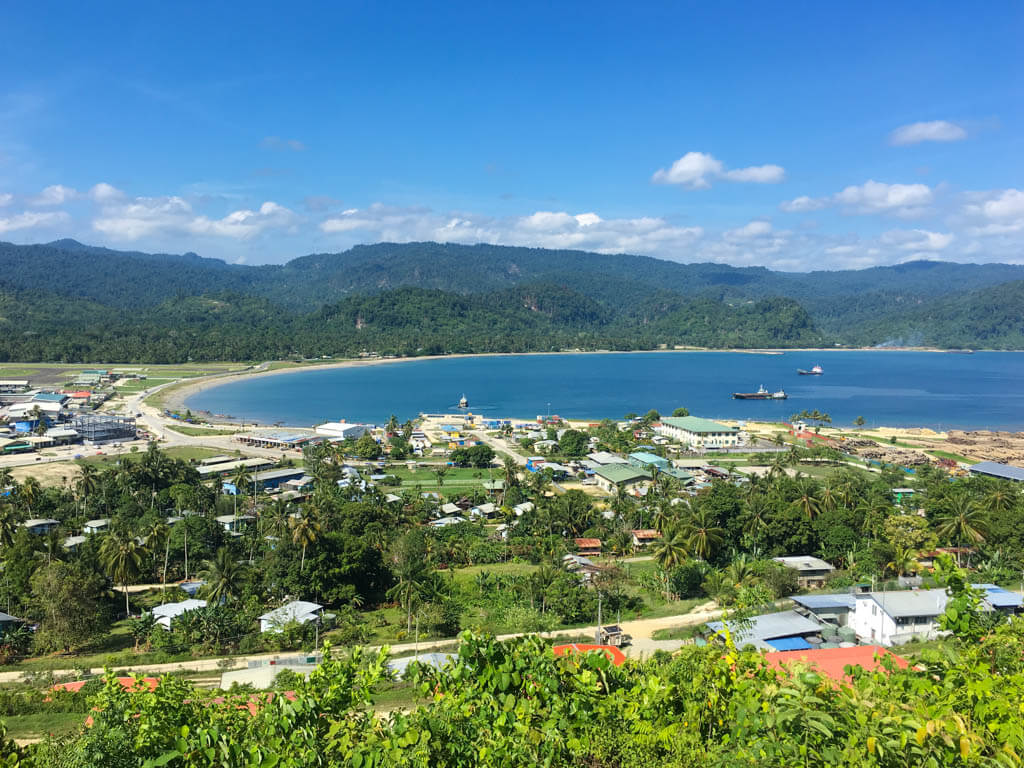
The pretty town of Vanimo.
I thanked the priest and headed down to the main market, where I enquired about budget accommodation with the local stall holders. A friendly lady selling betel nut, the local drug of choice, mentioned that there are cheaper places a little way along the coast, heading back towards the Indonesian border, for maybe 100 kina (€27.36/$29.24) a night and offered to go with me to have a look. I thought that would give me time to build rapport and maybe get invited home, so I agreed and we caught a local minibus along the coast (I paid for both of us, of course).
Just after we took our seats on the minibus, a lady entered holding a little girl in her arms. The girl, who was all smiles, took one look at me and burst into tears! “Shhhh, shhhh”, the young mother said to her, looking embarrassed, and apologetically, “I’m sorry, I’m sorry”, to me. I told her not to worry, but despite all her efforts the child continued to wail until I got off the bus about 10 minutes later. When I alighted, it was as if a switch had been flipped and suddenly the child was all smiles again. It must’ve thought I was some kind of ghost!
We checked out a guest house, but it was still 150 kina a night. Then the lady said, “If you don’t mind, you could come with me back to my house. You could stay in the boys’ room. The conditions are basic, but you’d be welcome. Actually, one member of our family is married to a Samoan man and lives in New Zealand, but she’s back here visiting at the moment, so you could talk with her as well.” Jackpot! Exactly what I was hoping for.
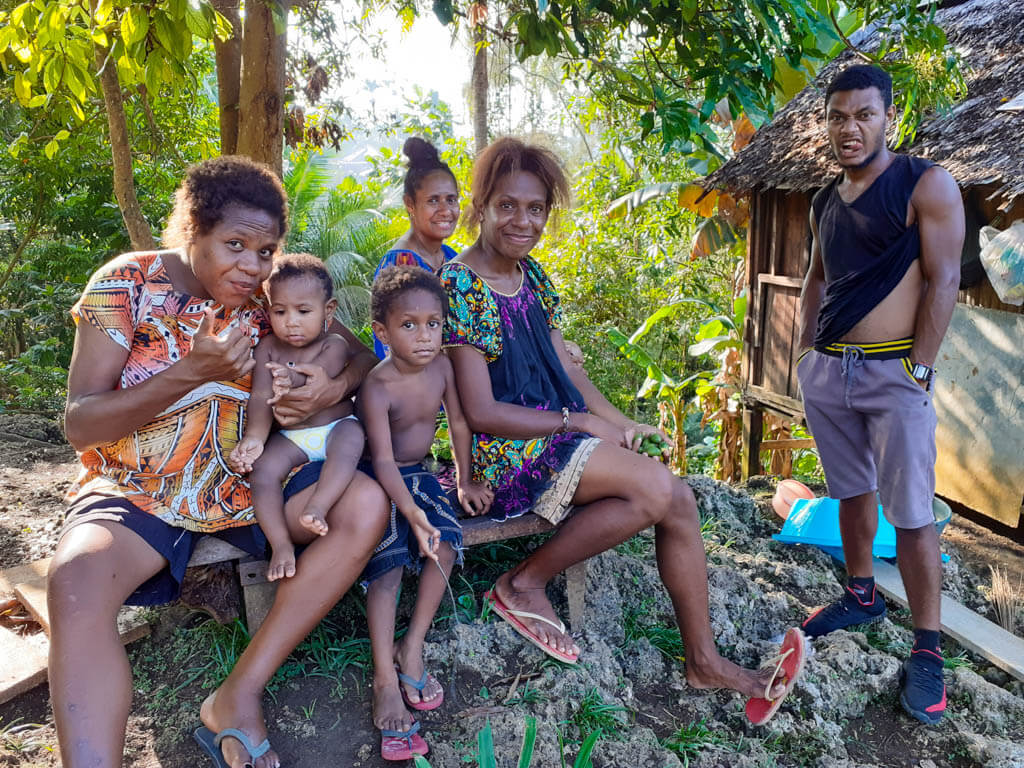
My beautiful host family in Vanimo, with Ismael on the right.
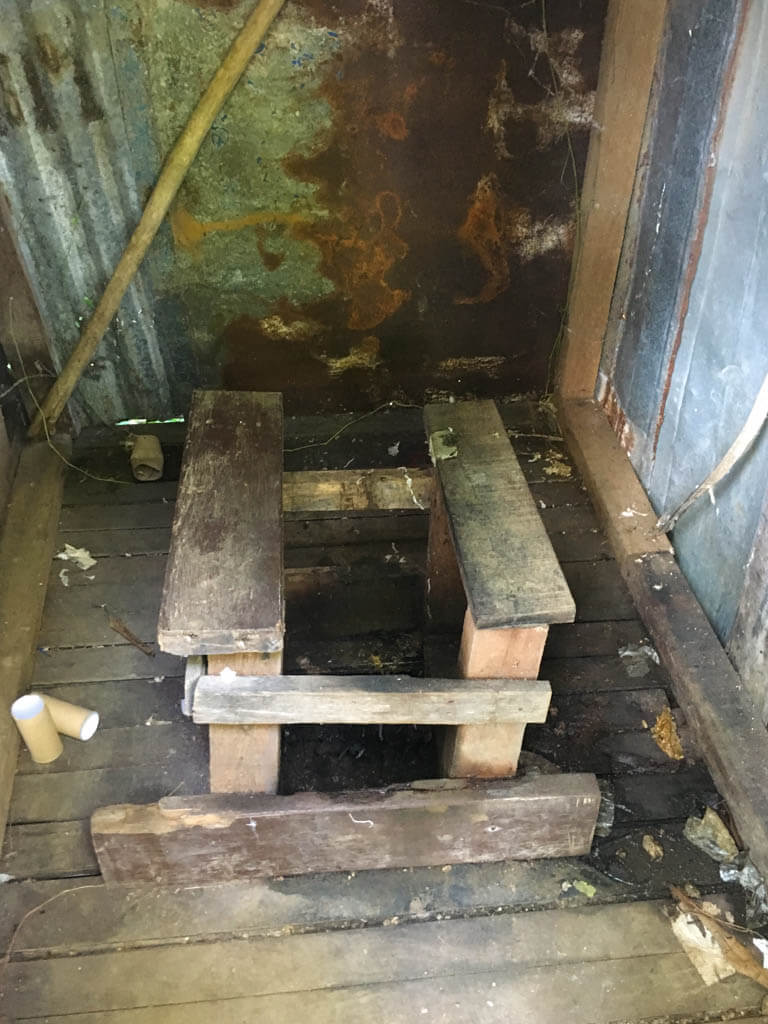
As I would later find out, this is luxury by PNG toilet standards
The accommodation was basic, with a pit latrine and simple bed, although after some discussion I actually stayed in the neighbor’s house, and had my own little room. Luxury for a homeless backpacker like myself. The bed was comfortable enough and there was a mosquito net (malaria is an issue in this region, so definitely worth having). A young man in the family, Ismael, (I think he was my host’s nephew), offered to show me around the town and I gratefully accepted. We picked up his friend James on the way and the two of them gave me a walking tour until sunset.
We did a circuit of the small peninsula on which Vanimo sits and Ismael and James showed me the town’s major landmarks, including the hospital, hotels, shops and even the local prison! Strolling by Vanimo’s main beach, with speedboats (although they called them banana boats) pulled up on the sand, they pointed out dozens of large fury fruit bats hanging upside down from the trees by the beach. They were too high up for my iPhone camera, but luckily the guys were both very into photography and one of them had a nice DSLR camera, so he took a few good shots for me. Actually, the whole time I was in Vanimo, Ismael pretty much acted as my photographer and took hundreds of great shots. Vanimo is a nice town – pretty, with a seaside atmosphere and beautiful beaches right next to the town centre.
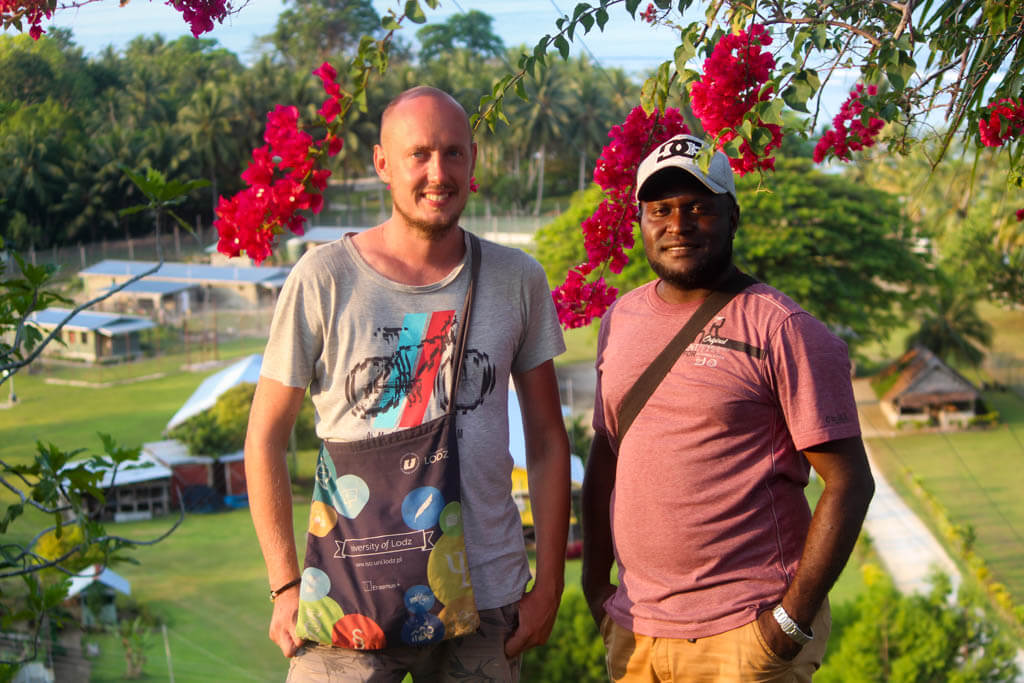
Me and James with Vanimo prison in the background
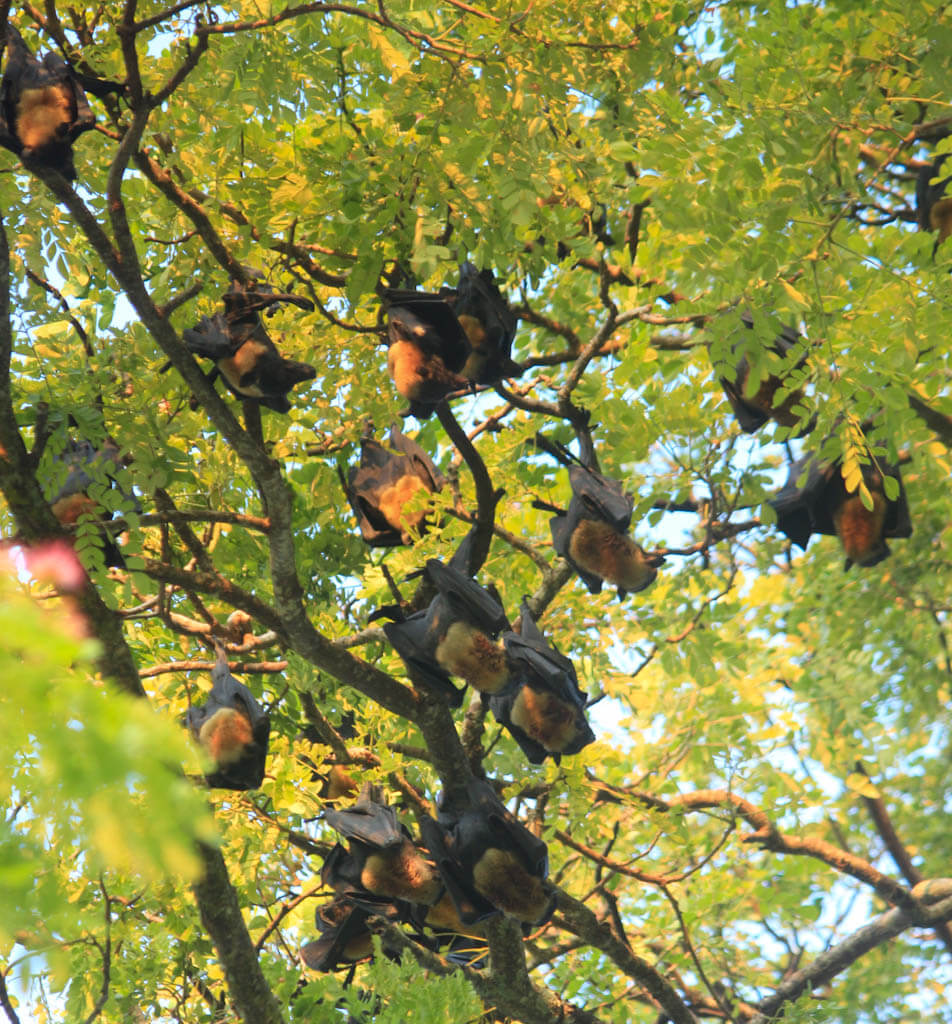
Fruit bats hanging upside down in the branches of a large tree by Vanimo beach.
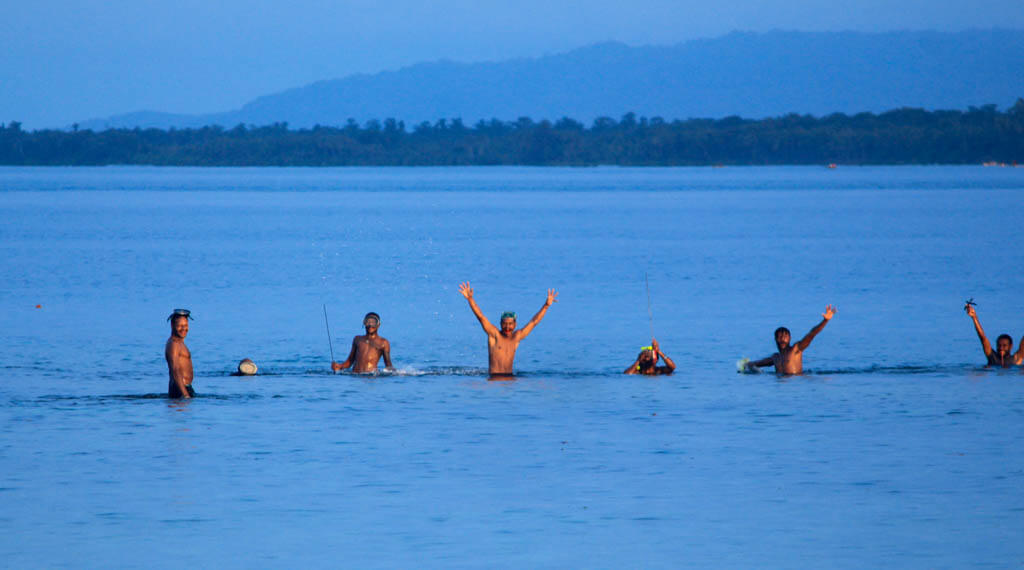
A group of kids waving at us from the sea in the twilight.
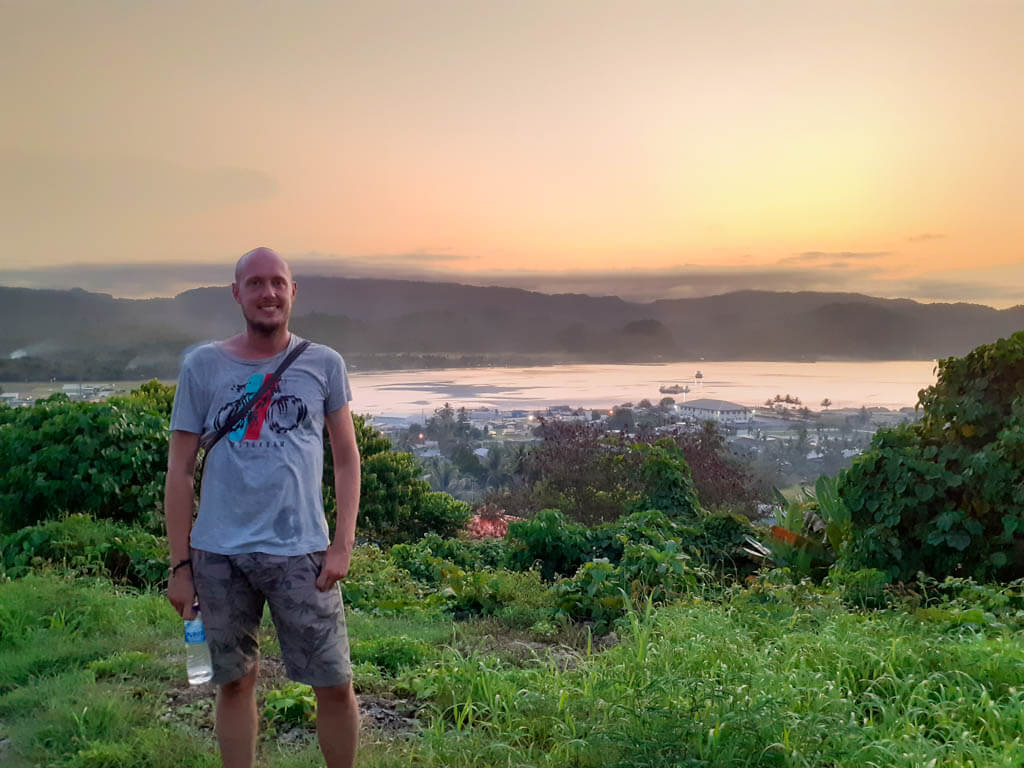
Sunset in Vanimo.
In the evening, we returned to the family home, where I met about ten members of Ismael’s family, including my host’s parents, the obvious heads of the family, and the lady with the Samoan husband. They were all very friendly and curious about my travels and background. They also cooked an amazing meal of chicken, vegetables, fish and rice, plus a double portion of sago especially for me, as it’s the staple food in this region and I’d mentioned that I hadn’t tried it yet. The meal was so huge that they had to put it on two plates, because one wasn’t big enough for everything. Luckily, I hadn’t eaten properly all day, so I happily cleared both plates with great enthusiasm.
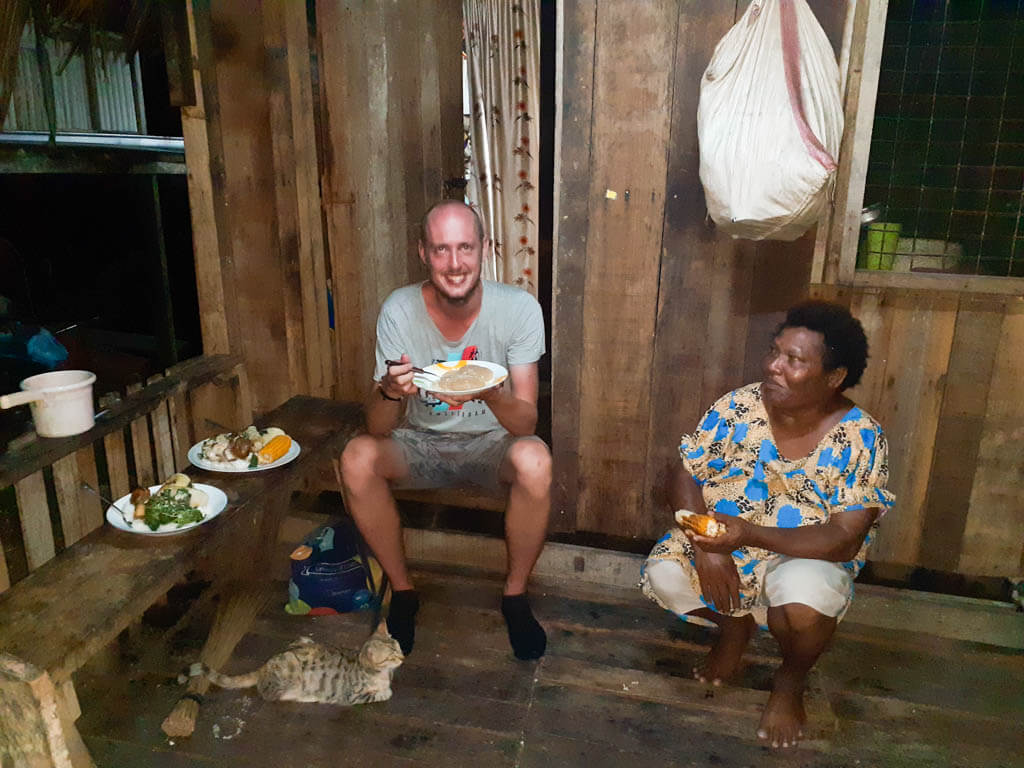
Enjoying my first sago in PNG.
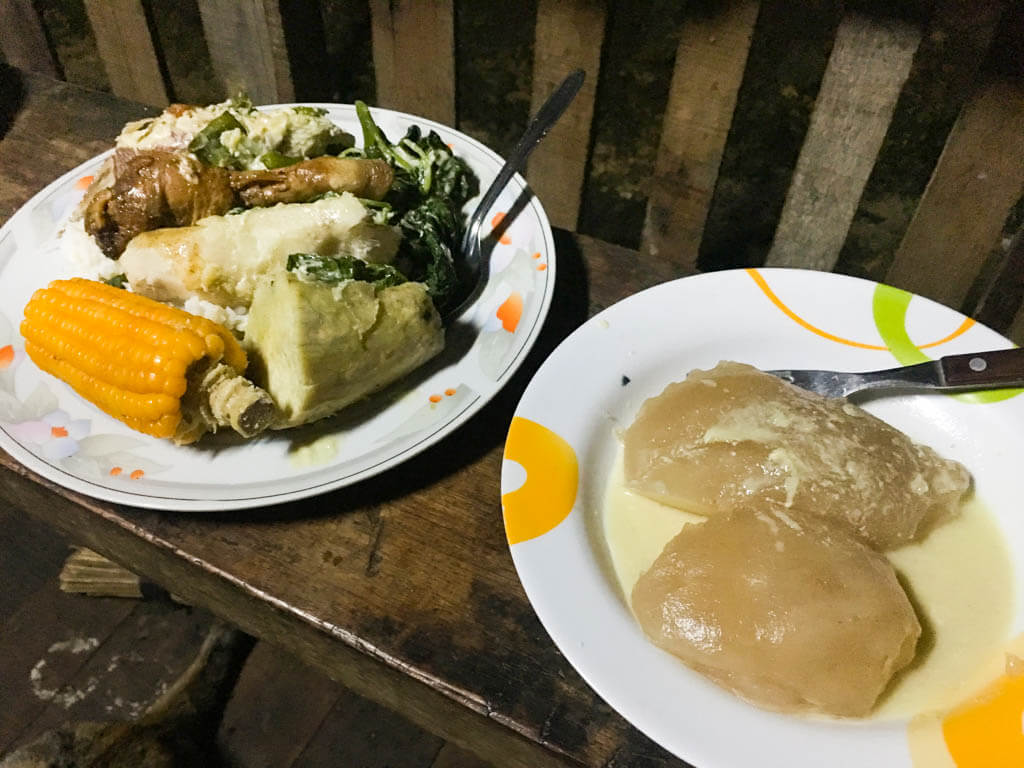
The hospitality was amazing – I could hardly walk afterwards!
It was actually my second time to eat sago, the gooey, semi-transparent staple food of northern PNG, as I’d tried papeda, another traditional sago-based dish, in West Papua the week before. The papeda was fun, because there’s a special method of eating it that involves rotating wooden forks around each other, but I enjoyed PNG’s sago much more. It was still tasteless, but something about the gooey texture appealed to me.
The next day, some other friends of Ismael and James joined us and we went to do some practical things, such as buying antimalarial medicine, which of course I hadn’t thought to bring (I had no idea malaria was a problem in PNG until I arrived), and a SIM card. We also stopped on a hilltop with a nice view and Ismael and James climbed up an electricity pylon to get better photographs. Then James’s dad appeared in his pickup and offered to drive us to a nearby waterfall. He took us a few minutes along the road back towards the Indonesian border and then we turned off into the jungle. Parking by a river, we hiked along its banks for about 20 minutes, until we came to a waterfall with a pool at the bottom that was deep enough to swim in.
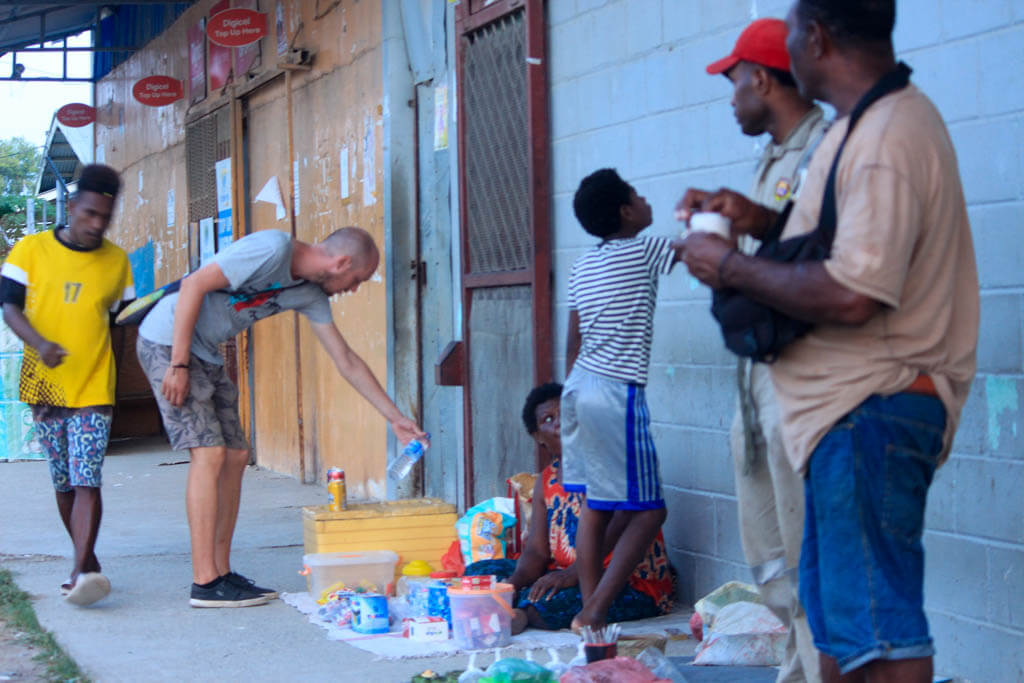
Buying water from a street vendor on the streets of Vanimo.
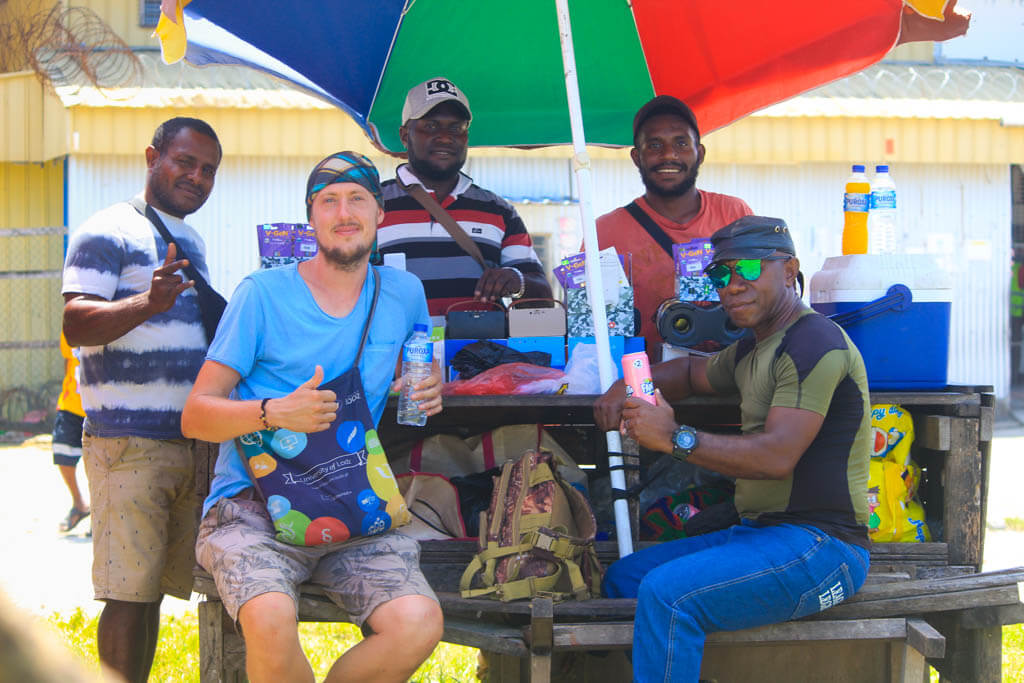
Hanging out in Vanimo market.
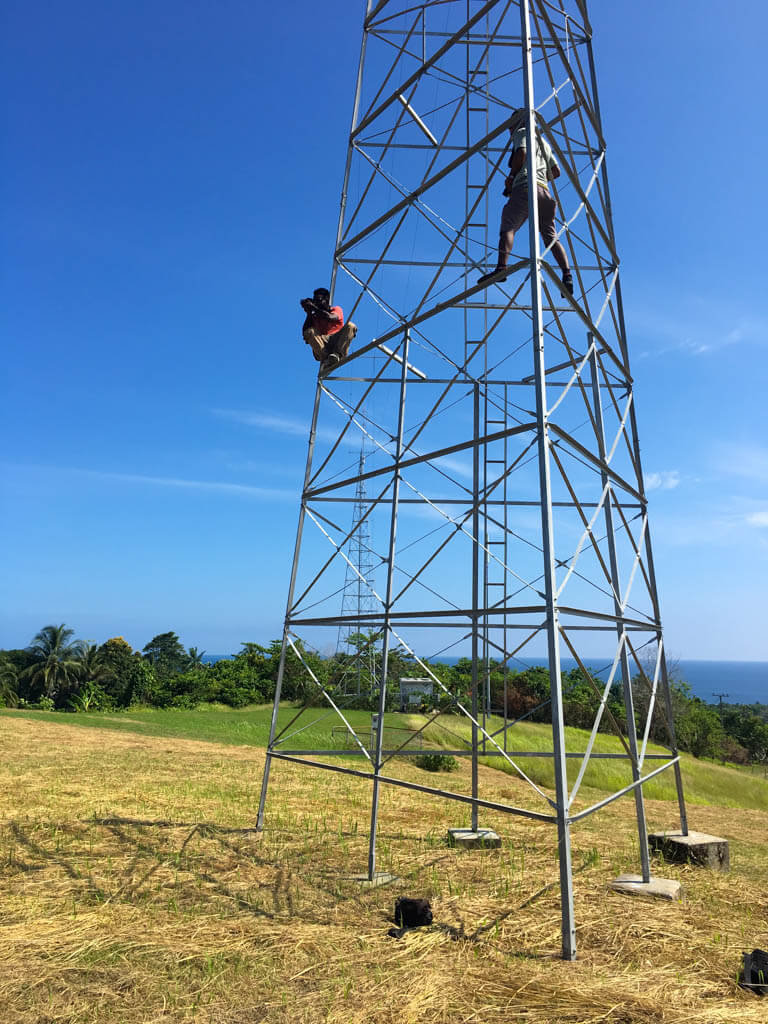
The guys climbing an electricity pylon to take better photographs. That’s dedication!
The pool was nicely shaded, which is great for me, as the day was blisteringly hot by then and I become a lobster in no time if I stay in the sun for too long – a fact that I would be painfully reminded of the next day. We all jumped in and the cool water felt amazing. The place was beautiful and the rocks above the pool formed multiple natural levels – perfect for jumping into the pool below. We all took turns climbing up them and jumping off, each from different levels depending on how experienced or brave we were. It was like a multilevel diving board. We had to be very careful though, because some parts of the pool were not so deep.
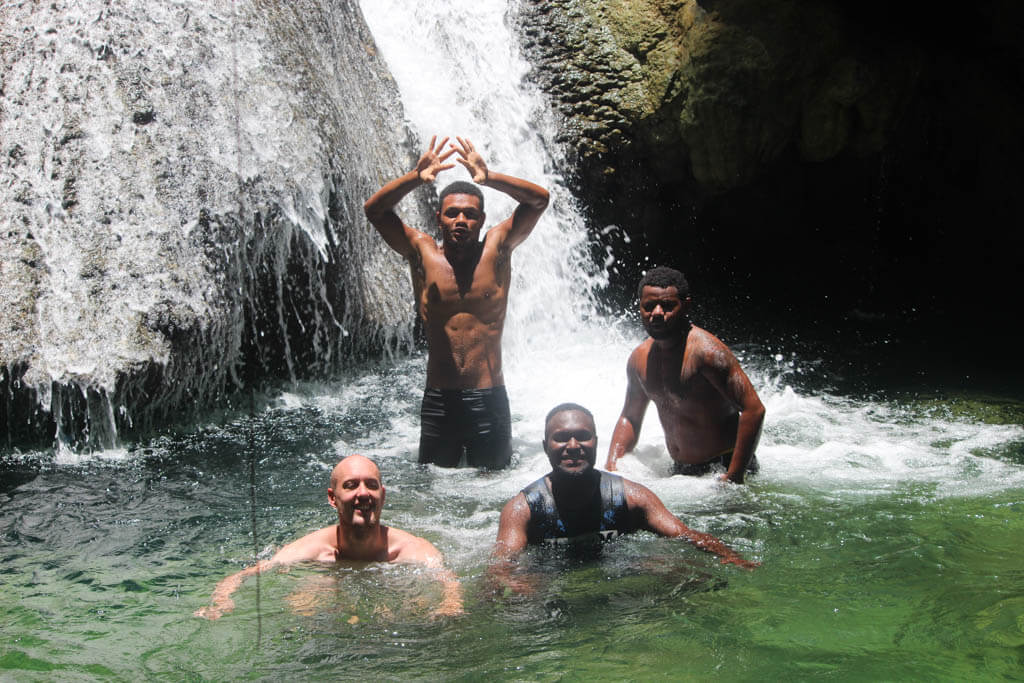
Enjoying the cool water.
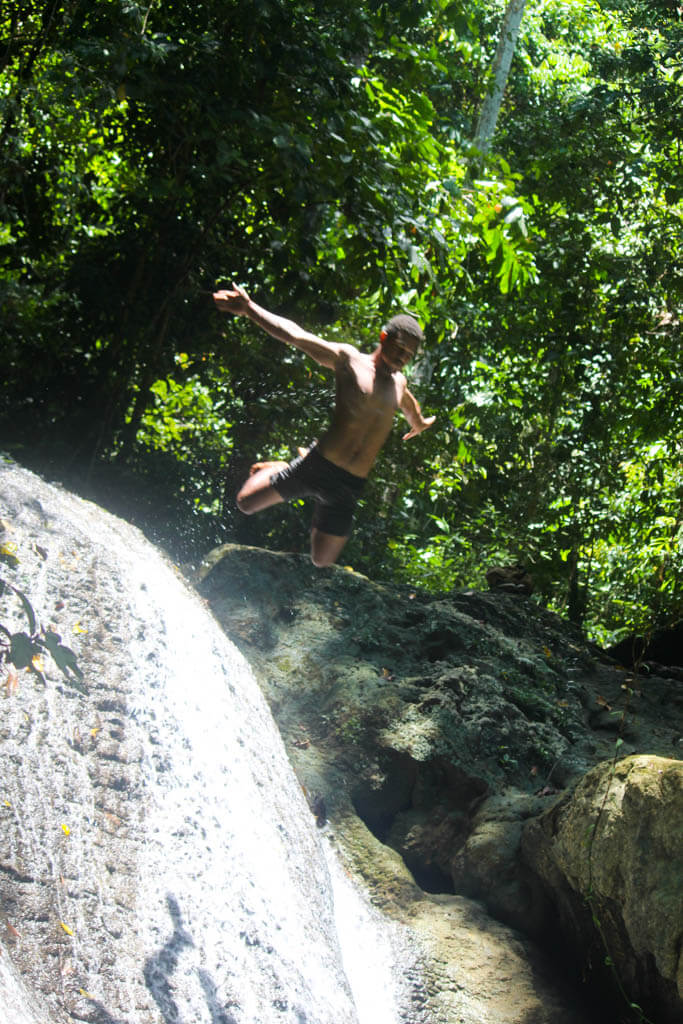
Ismael learning to fly!
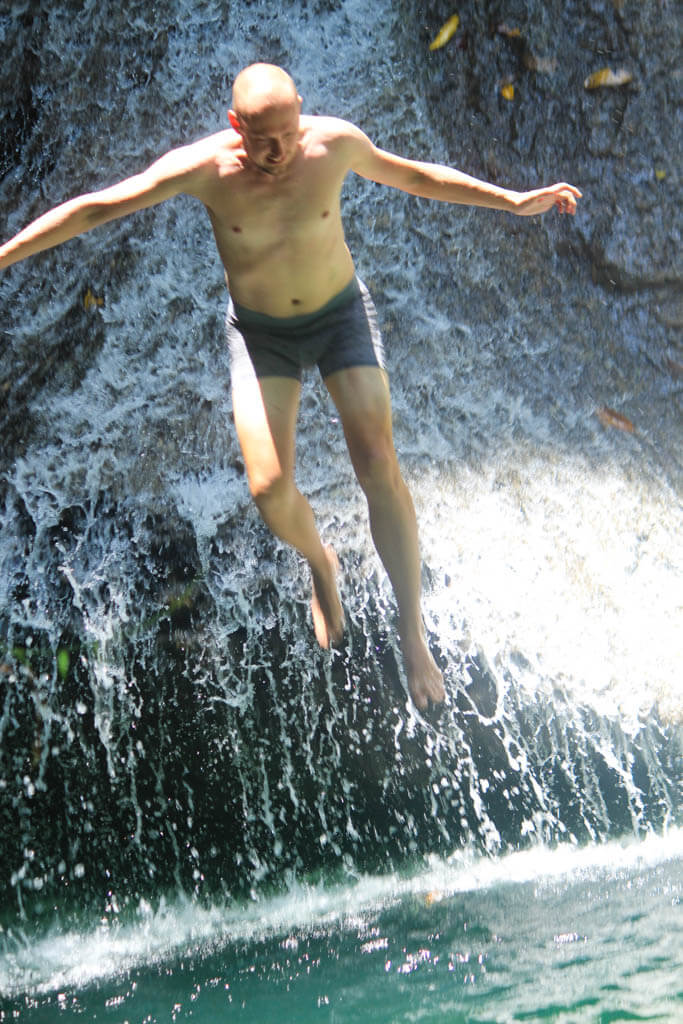
I fell rather than flew, but enjoyed doing it!
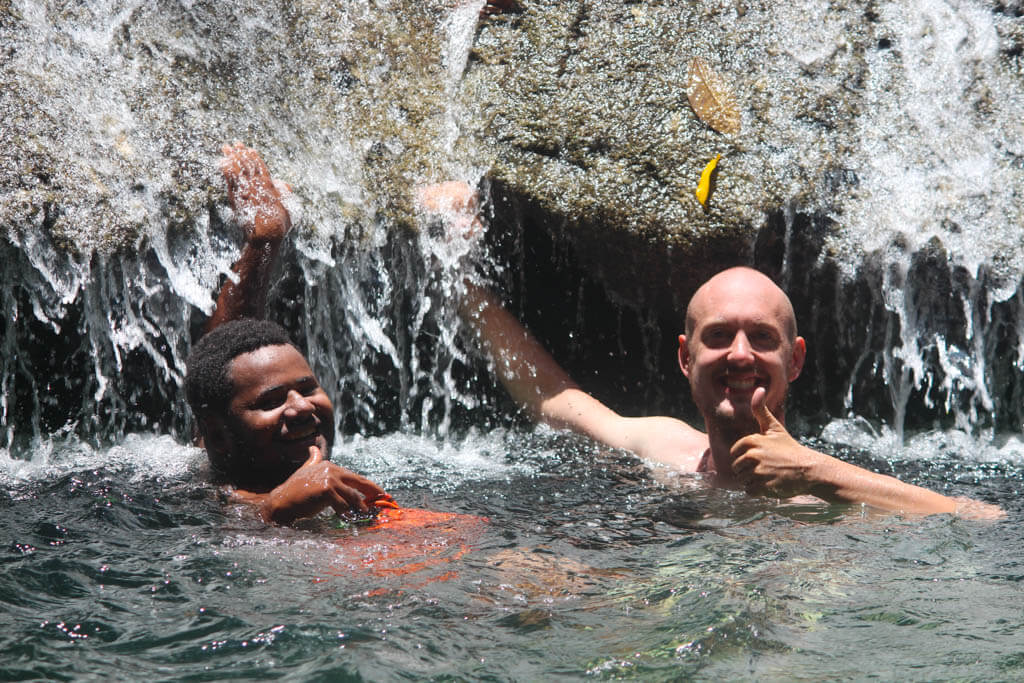
Everyone look at the camera.
After we returned to the town, I said I wanted to go to Narimo Island, a twenty-minute boat ride from the Vanimo coast. After some discussion, we found a lad with a boat on the beach and I agreed to buy fuel for the journey. I paid 100 kina (€26.70/$29.40) for the fuel, which was far too much for the short journey to the island, but as they were hosting me, I really didn’t mind paying for some fuel for them to use later as well, so I didn’t question it. James’ dad got everyone some delicious sago and fish wrapped in banana leaves for lunch, and then we jumped in the boat and headed out to the island.
Narimo is tiny, with a little patch of jungle above cliffs maybe 10m high on one side and a picturesque sandy beach on the other. We spent a relaxed afternoon exploring the jungle (which took ten minutes), hanging out on the beach, taking photographs and swimming in the sea. I also had a chat with the boat’s skipper about my planned trip to Aitape, a small town five hours along the coast by boat, the next day.
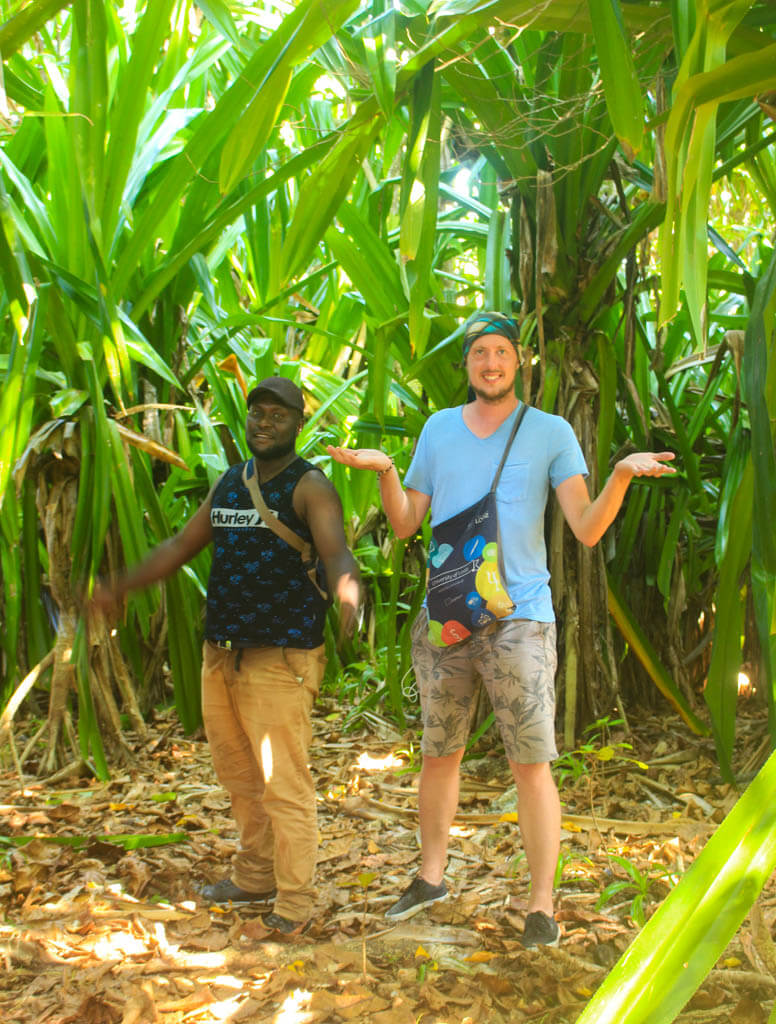
Jungle fun.
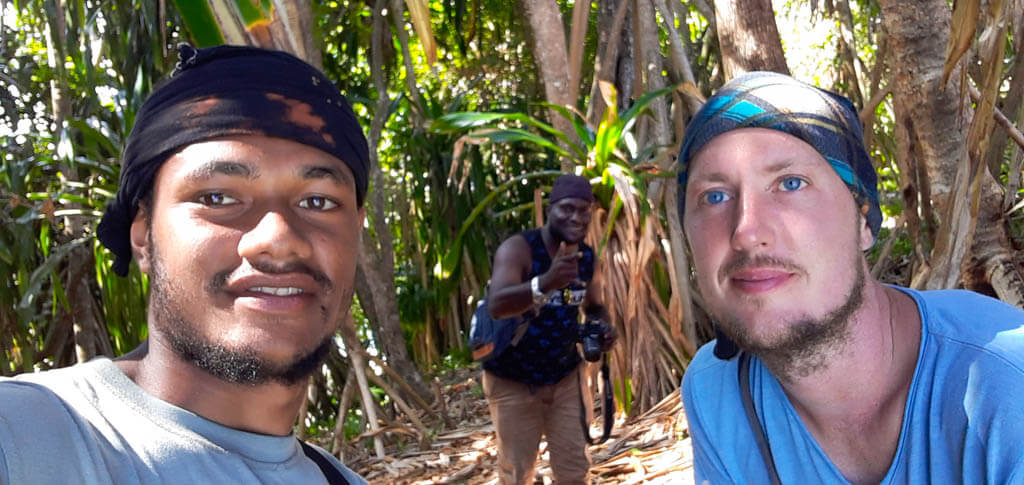
Exploring the Narimo island jungle.
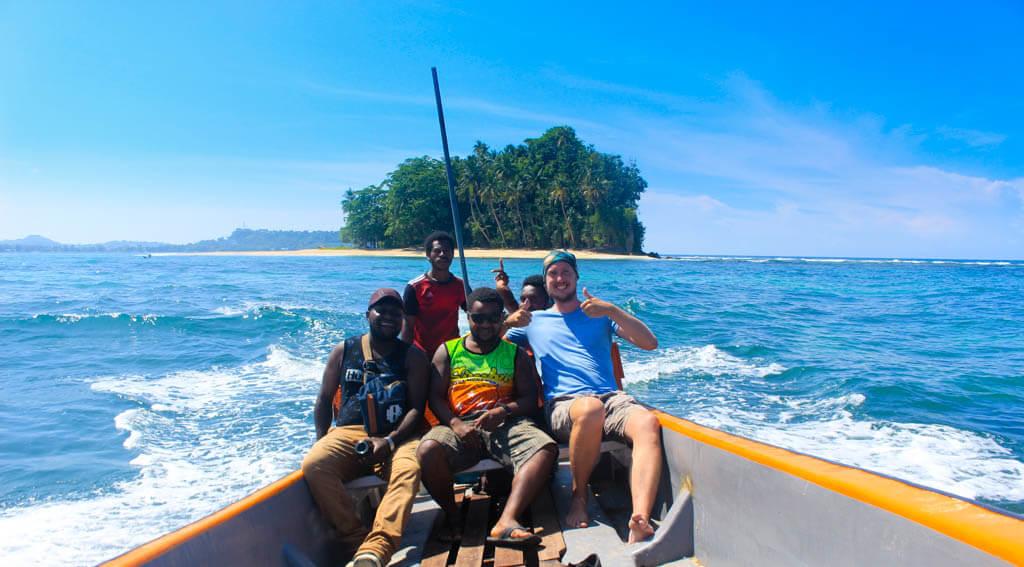
Posing on the photo in the banana boat to Narimo.
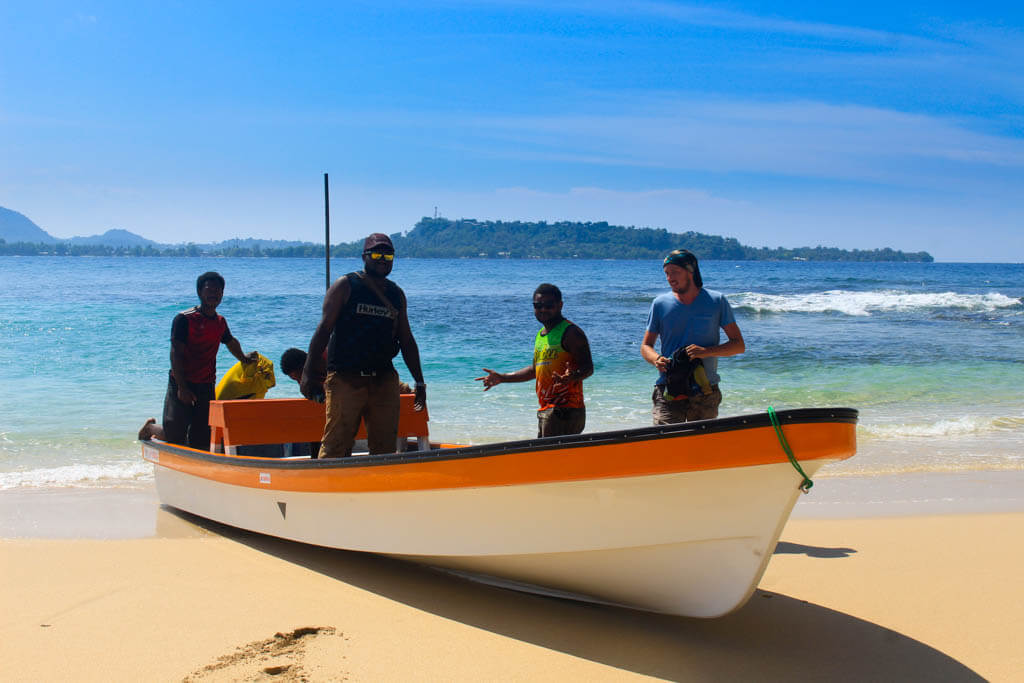
Landing on Narimo island beach.
Although there is technically a road from Vanimo to Aitape, it’s impassable due to a collapsed bridge and lack of maintenance, so the only way to travel between the two is by boat. Actually, the situation is a complete mess, like pretty much anything to do with infrastructure in PNG. The road used to be owned and maintained by a logging company, but then they left and the government didn’t bother to maintain it, so it slowly fell apart until it became completely impassable.
I’m sure some well-connected person is making money from the situation somewhere – in PNG that’s always the way. Like the country’s unreliable power grid. Half the country isn’t connected to the grid anyway (the half that’s too poor to pay) and the other half suffer constant power cuts. And guess what? According to the locals, the only company with a license to import diesel generators is owned by a well-connected government official. Anyone smell a rat yet? All this is common knowledge, yet people are so busy struggling to survive that they don’t have the energy to do anything about it.
The skipper told me to leave early the next day, preferably 6-7am, as the sea becomes rough in the afternoon, and to look for a boat with an older skipper, as they’re likely to be more experienced. “And believe me,” he said in a warning tone, “plenty of boats have sunk along that route”. I remember his exact words.
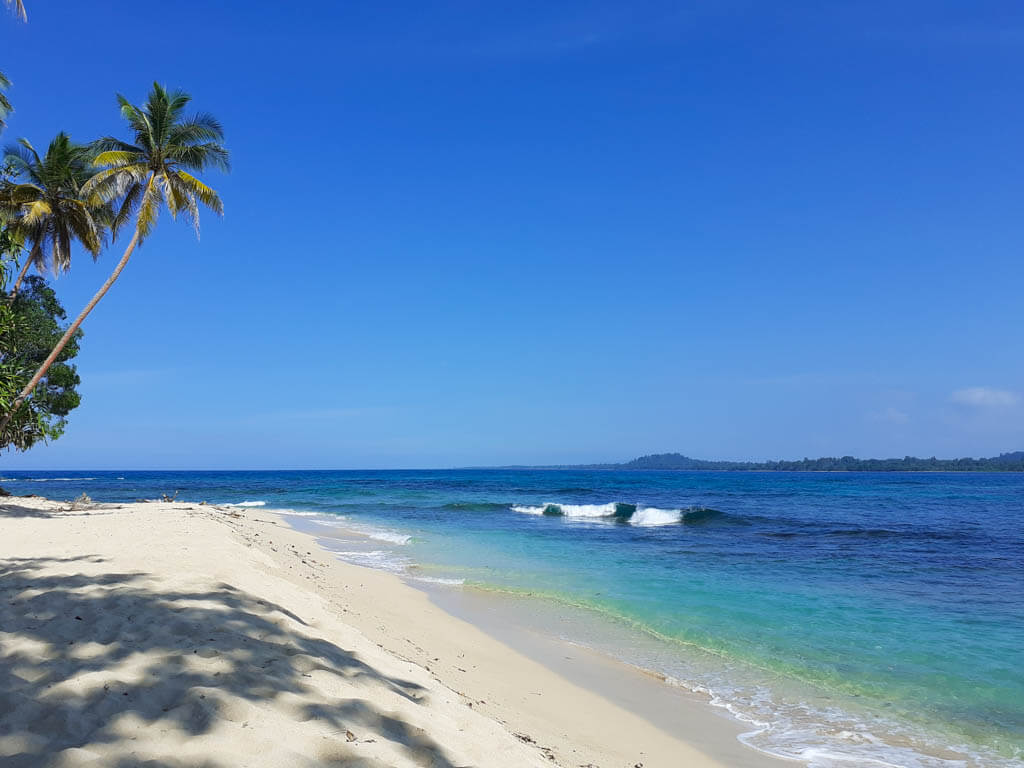
The beautiful white sand of Narimo beach.
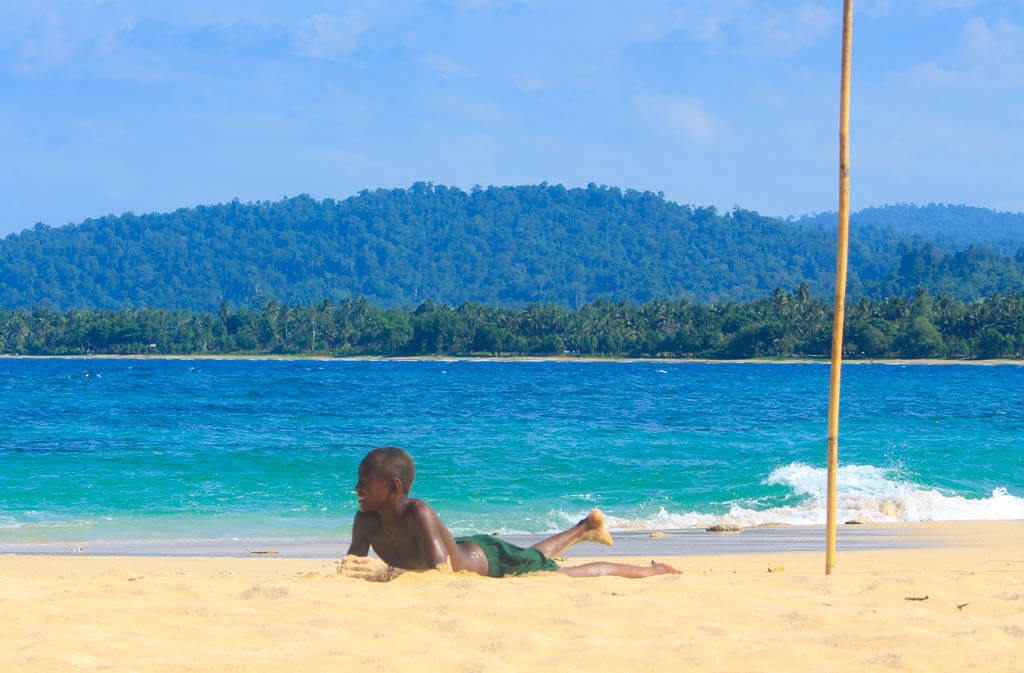
A child skips school to relax on the beach.
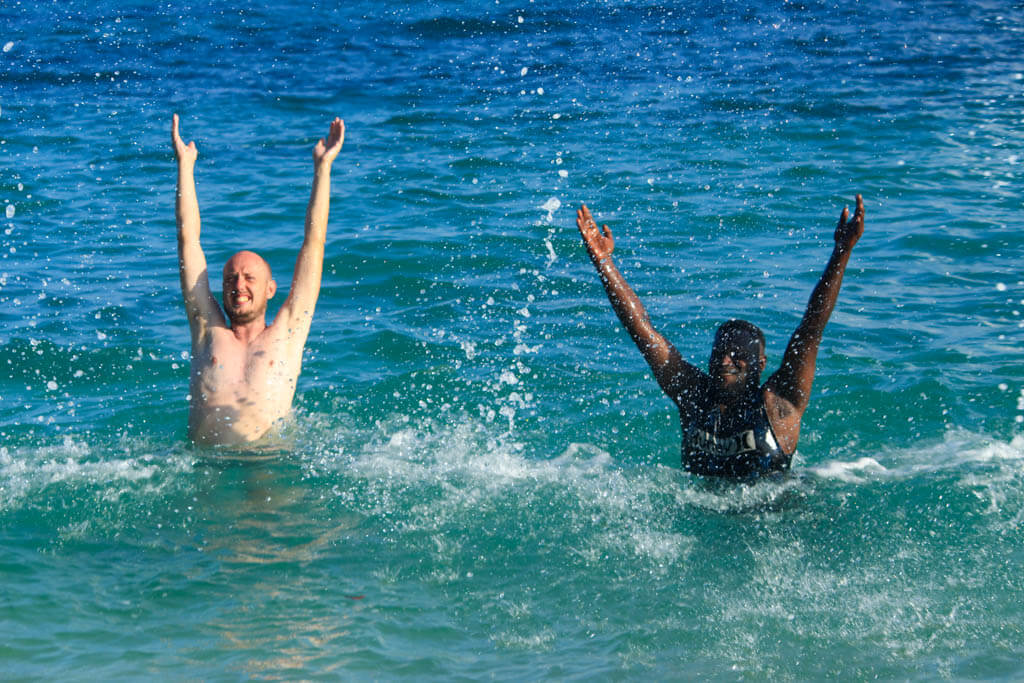
Playing in the sea.
We had the island to ourselves, apart from a few primary-age kids, who apparently were hiding out there because their parents didn’t send them to school. Unfortunately, in PNG even primary education is not free, so their parents probably couldn’t afford the school fees and instead sent them to the island during the day to avoid the authorities. They had a little wooden fishing canoe and let me paddle it with them for a bit. I got quite carried away, paddling in circles as fast as I could, but what I didn’t realise until too late was that my frantic paddling was causing the boat to take in water at the back. Suddenly, I found myself sitting in water – I’d sunk their boat! Fortunately, the kids had a great sense of humour and I helped them scoop the water out of it and get it floating again.
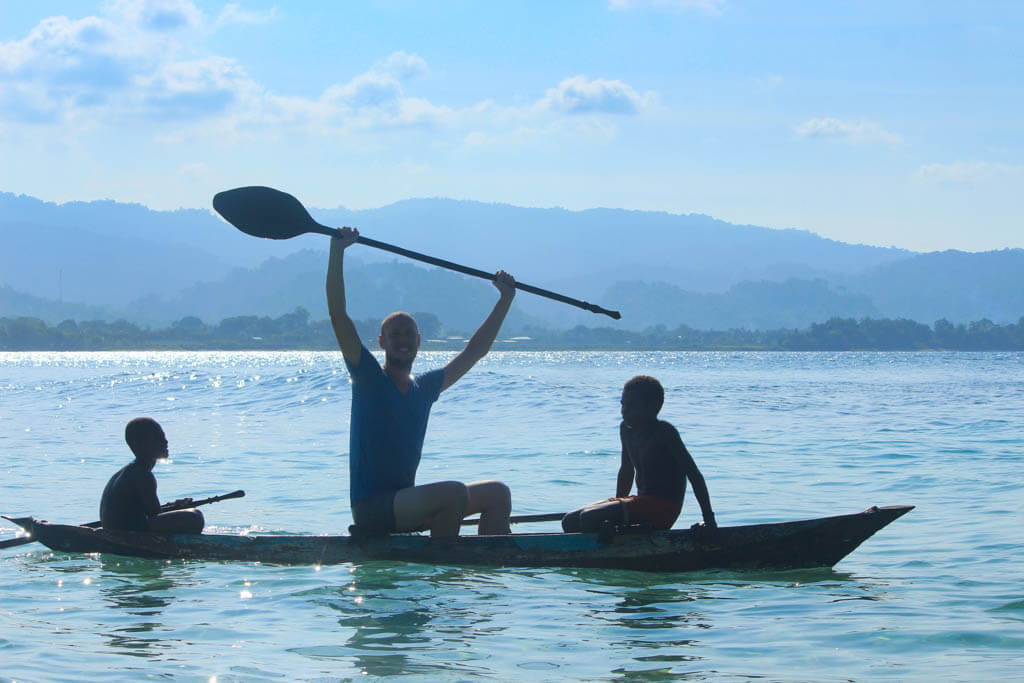
Me showing off on children’s boat.
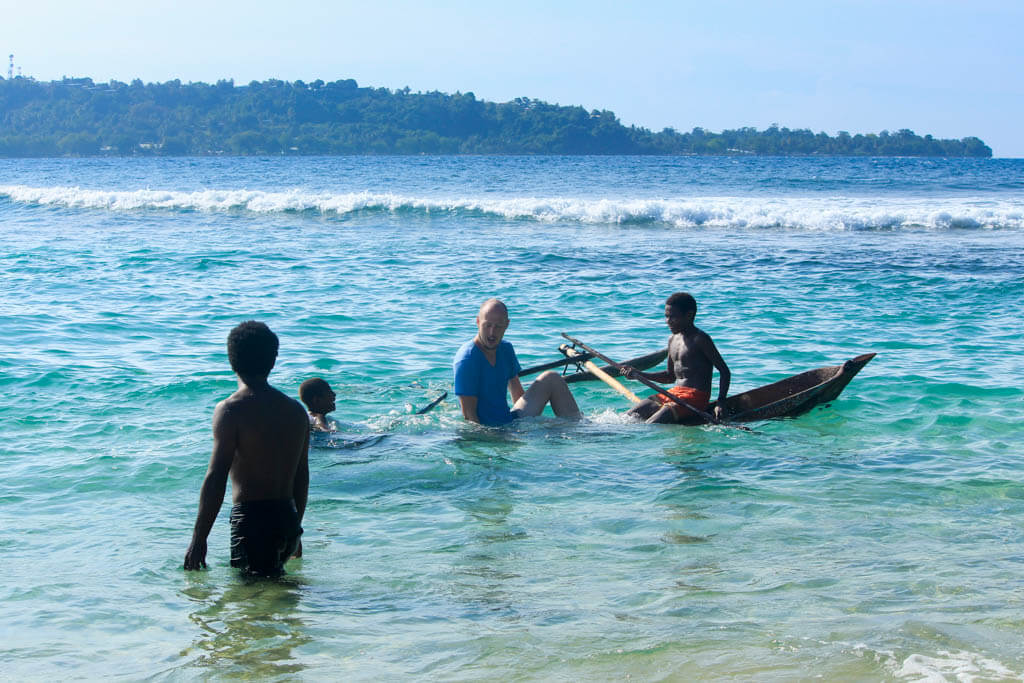
Ooops, I didn’t mean to…
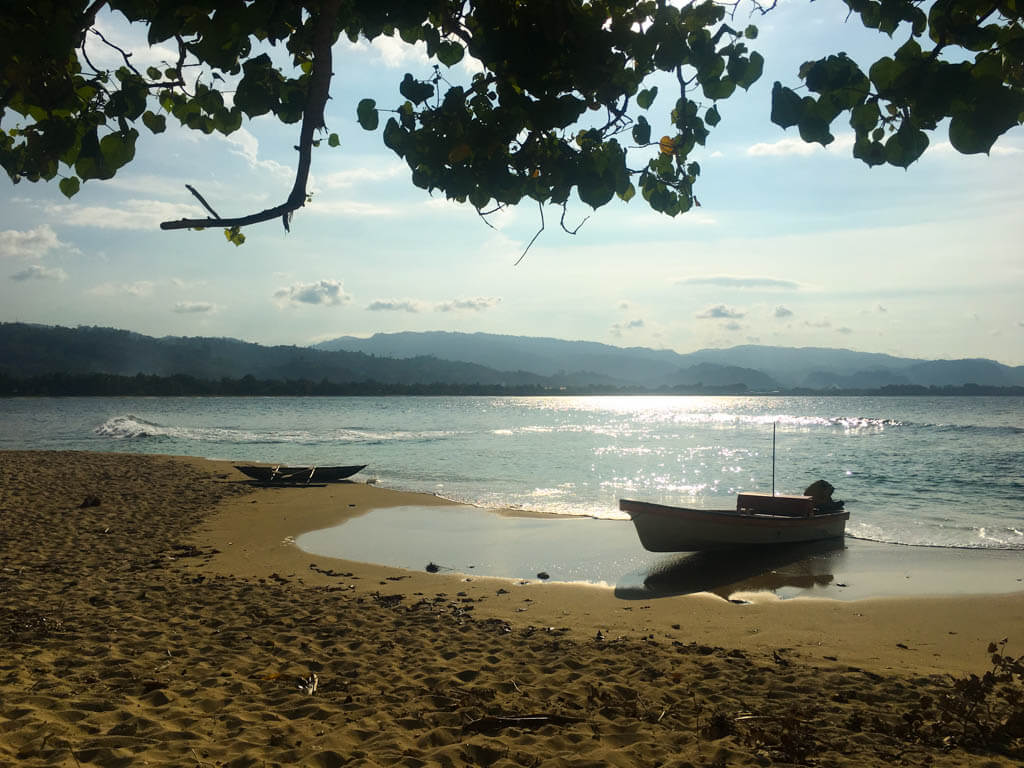
Sunset on Narimo beach.
The day ended with two dinners! The first at James’ house and the second at Ismael’s. Unfortunately, I didn’t realise we were going to both, so I had second helpings at James’ and then could hardly move by the time we finished at Ismael’s. The hospitality here is amazing. Ismael’s family also had friends in Aitape, my next destination along the coast, and kindly arranged for me to stay with them the following night.
The next morning, Ismael, James and his father took me to the docks and found me a boat to Aitape. Unfortunately, despite arriving about 7am, the departure was delayed due to a rain shower and it was well past 10am by the time we finally departed. At least the skipper was middle aged and seemed rugged enough that I trusted he was experienced! The sea was calm enough in the beginning, and pulling out of Vanimo harbour we were treated to the sight of flying fish skimming above the gentle waves, a beautiful sight that I’d only seen in the Maldives previously. The sea became progressively rougher as we progressed, especially when we passed a couple of river deltas, where the mixing of the two waters made the going even choppier. It was interesting how distinct the two waters were as they mixed. A clear line was visible between the greenish-coloured river water and the grey-blue of the sea water, even far out from the coast.
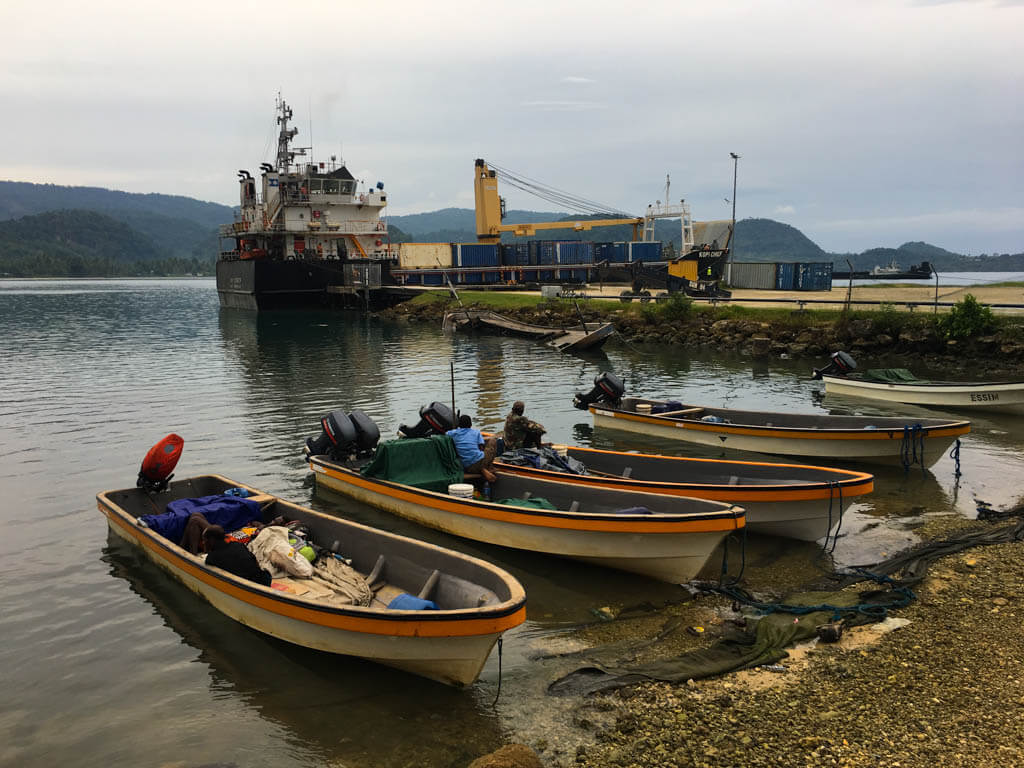
Banana boats waiting in Vanimo harbour to brave the journey to Aitape.
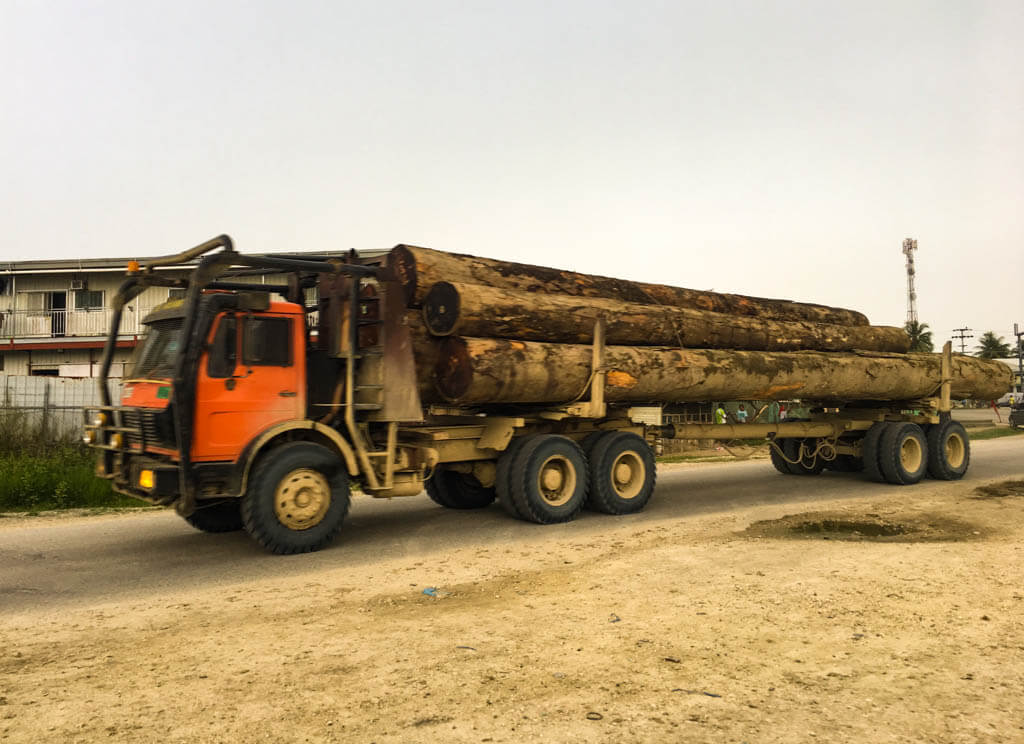
Logging of the Papua New Guinean jungle is a big industry in this area of PNG.
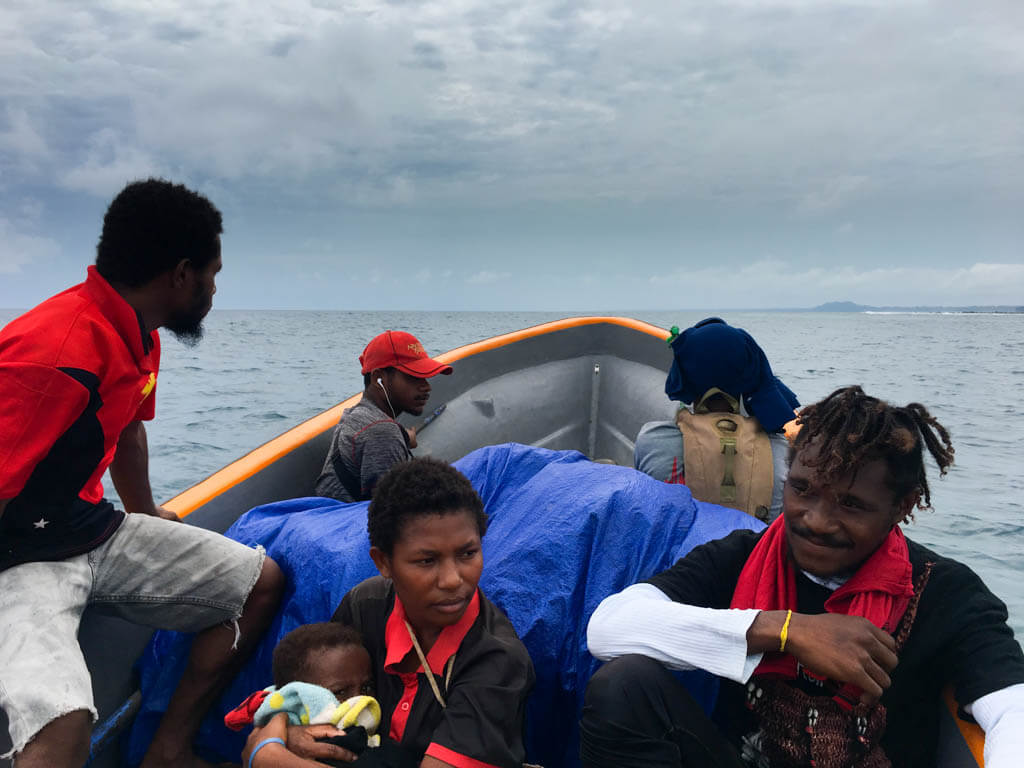
Intrepid travellers – the gentle start to our journey to Aitape.
At one point we spotted a couple of dolphins jumping in the distance and, although they weren’t close enough to see clearly, we could still see how graceful they were even at that distance. About three hours into the journey, the sea became so rough that one lady threw up over the side of the boat. She then proceeded to lie on the floor with her eyes closed until we reached Aitape. She even stopped chewing betel nut, which Papua New Guineans never do, so she must have felt really ill! By this time, the sky had cleared and it was beautifully sunny, which left me with another problem – I was wearing shorts and my legs were slowly cooking in the head. Unfortunately, because the sky had been so overcast in the morning, I’d left my sunblock in my backpack, which was now buried under a lot of other luggage in the bottom of the boat, and not accessible with the choppy water. All I could do was try to cover my legs as best I could with my jacket. When we finally arrived in Aitape bay, around 3pm, the whole boat breathed a sigh of relief.
The friends of my hosts in Vanimo were sitting on the docks waiting for me and welcomed me to the town. I had my own room in a little shed separate from the main house. The house itself was a crazy looking wooden structure, that reminded me of something out of the Adam’s Family, but was beautiful in that unique way that only delaying old architecture can be. It was only about 3pm and two young men at the house offered to show me around the town, so of course I jumped at their offer.
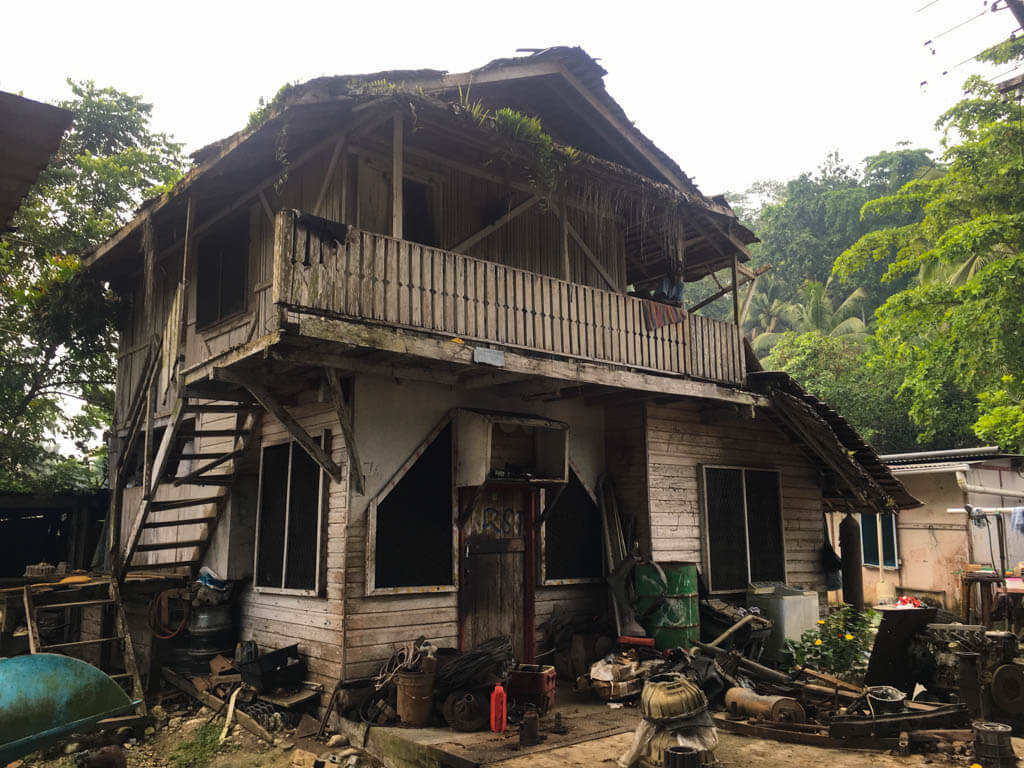
They’re creepy and they’re kooky, mysterious and spooky…
Aitape is not big, but it’s split across three different villages, with a minibus running between them, so quite spread out. It was also a site of conflict during the Japanese occupation of PNG in World War Two and the boys took me to an old Japanese prison, although really there’s just a shell left. There’s also the remains of a Japanese plane, but it was too far for us to visit that day. Aside from that, I saw the village market, where I bought some sausage rolls and a street preacher preached with a microphone and speakers, the local hospital, the local high school with a large church connected to it, and learnt that the majority of the land in the area belongs to the local church mission, not the government. Friendly villages waved curiously and greeted me as I walked with calls of “Havinoon”, Pidgin for “Have a good afternoon”! The village is nice enough, and very friendly, but not as pretty as Vanimo.
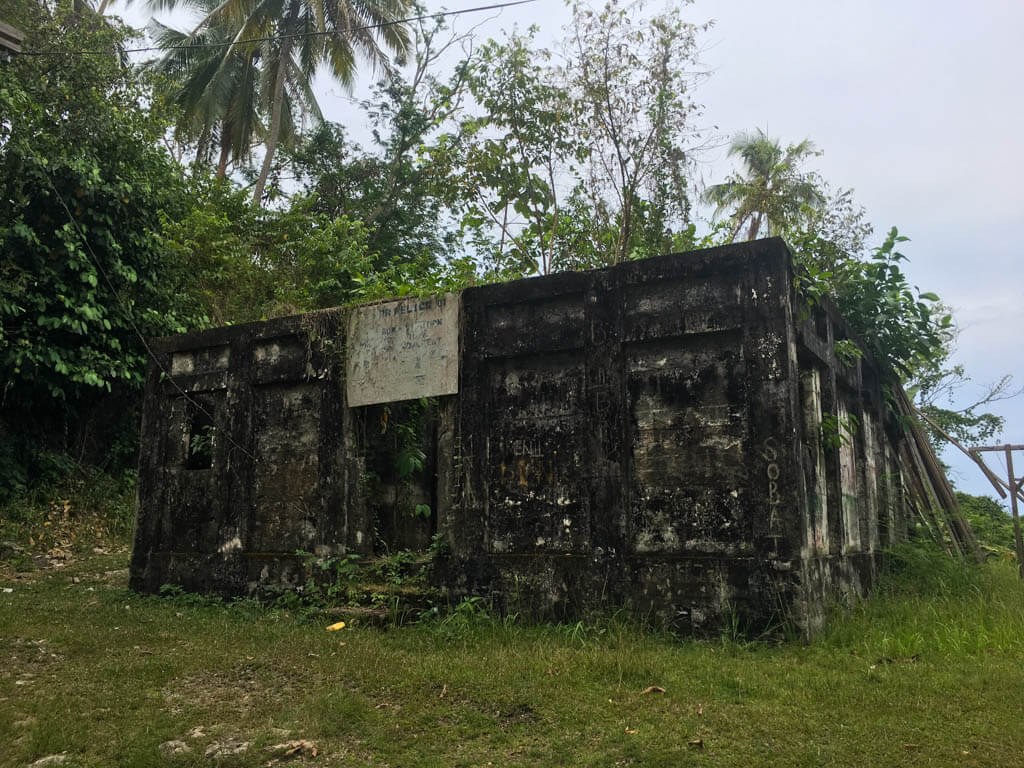
The ruins of the Japanese World War Two prison.
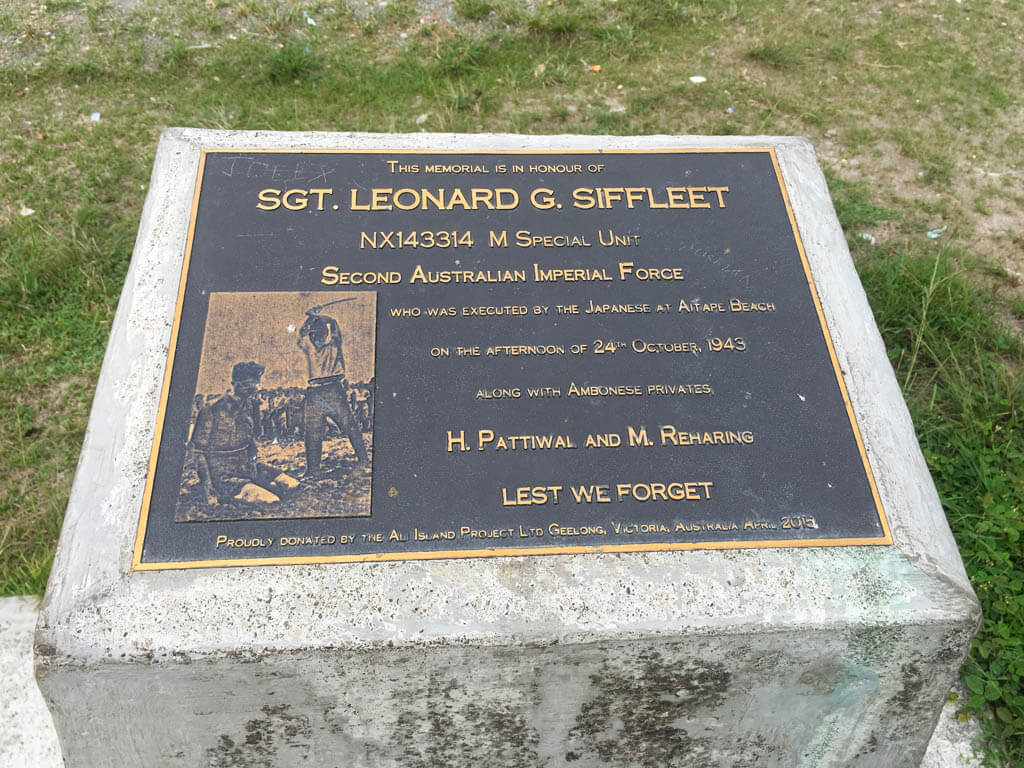
A plaque commemorating the execution of an Australian soldier during World War Two.
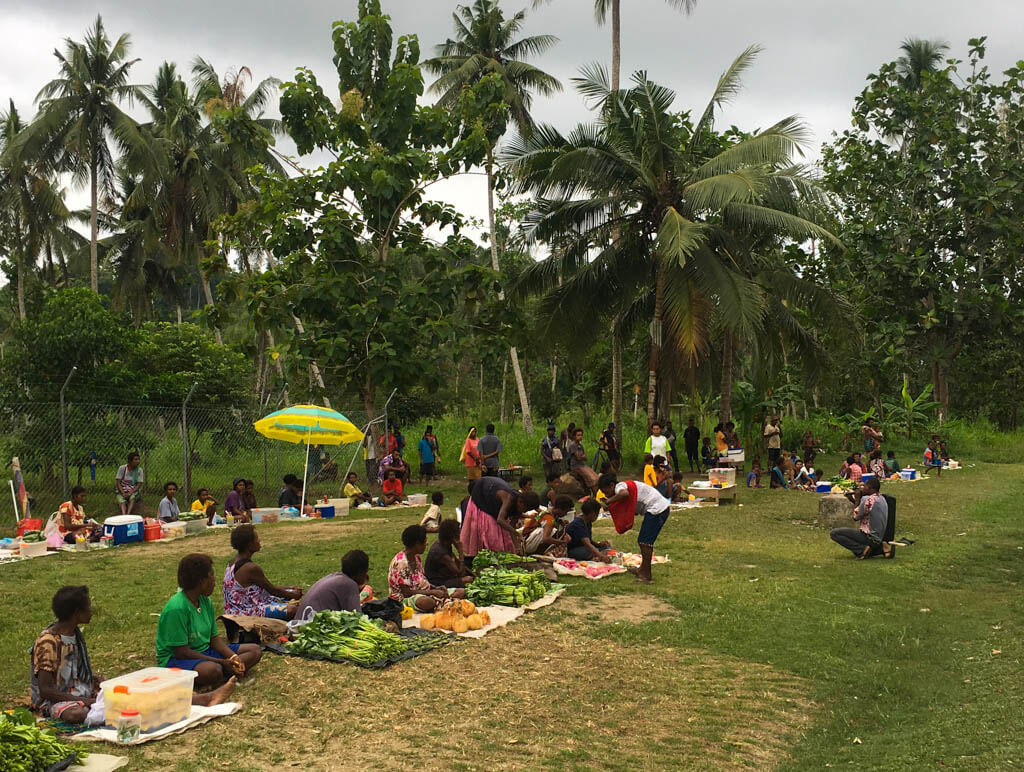
A local market in Aitape, with a street preacher doing his thing with a microphone and speaker system.
That evening, my legs were so painful from the sunburn that I could hardly walk. I hadn’t realised while clinging on to the boat for dear life that it was that severe. My hosts cooked me a nice meal of rice and canned fish and I slept well in my little shed. The next morning, I hung out with my hosts and went with the boys to find a PMV to Wewak, the next stop on my route and the gateway to the Sepik river, the part of PNG I wanted to see most.. A PMV is a shared Public Motor Vehicle and can refer to a minibus, pickup or even a boat in some cases – any vehicle into which far too many people can be crammed.
While waiting for the PMV to find enough passengers for the journey, I hung out in the kitchen (always stay close to the food!) where my host was cooking delicious pancakes fried in oil. I also found a curious empty alcohol bottle lying by the docks – Warrior Dark Rum, a local PNG brand. At this point I still had no idea of how big a role alcohol plays in PNG society, although even in Aitape there were a few drunks hanging around at 10am near the house where I was staying. The boys also took me down to the coast, where I climbed over some rocks with the locals kids and admired the view of the sea. Finally, the PMV arrived and I was given the front seat (abusing my status as a foreigner? Me? Never!). After I thanked my hosts and said goodbye, we headed off to Wewak on what would prove to be one of the most dangerous parts of the trip, but that’s another story…
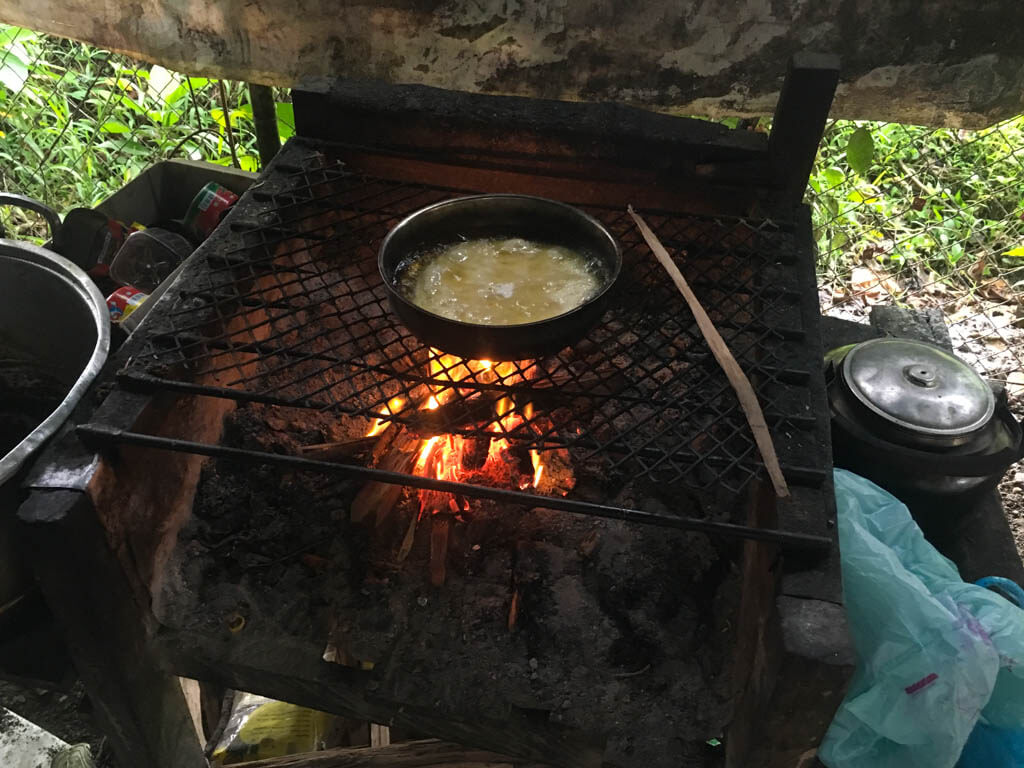
Cooking pancakes in an outdoor kitchen.
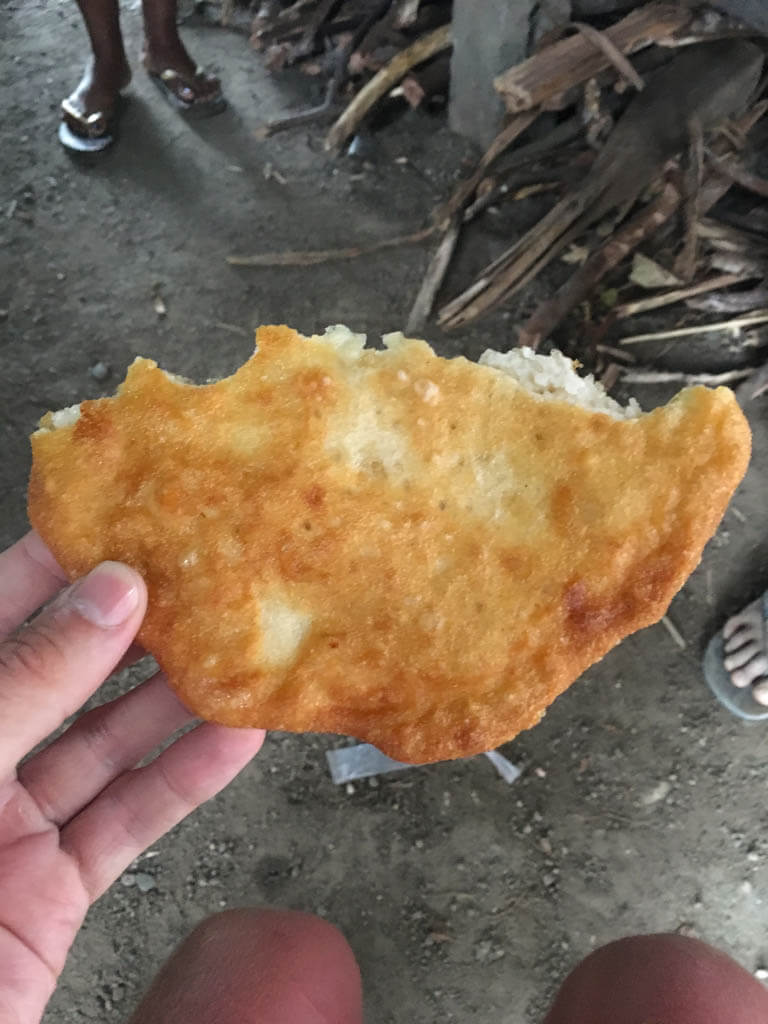
Delicious pancakes.
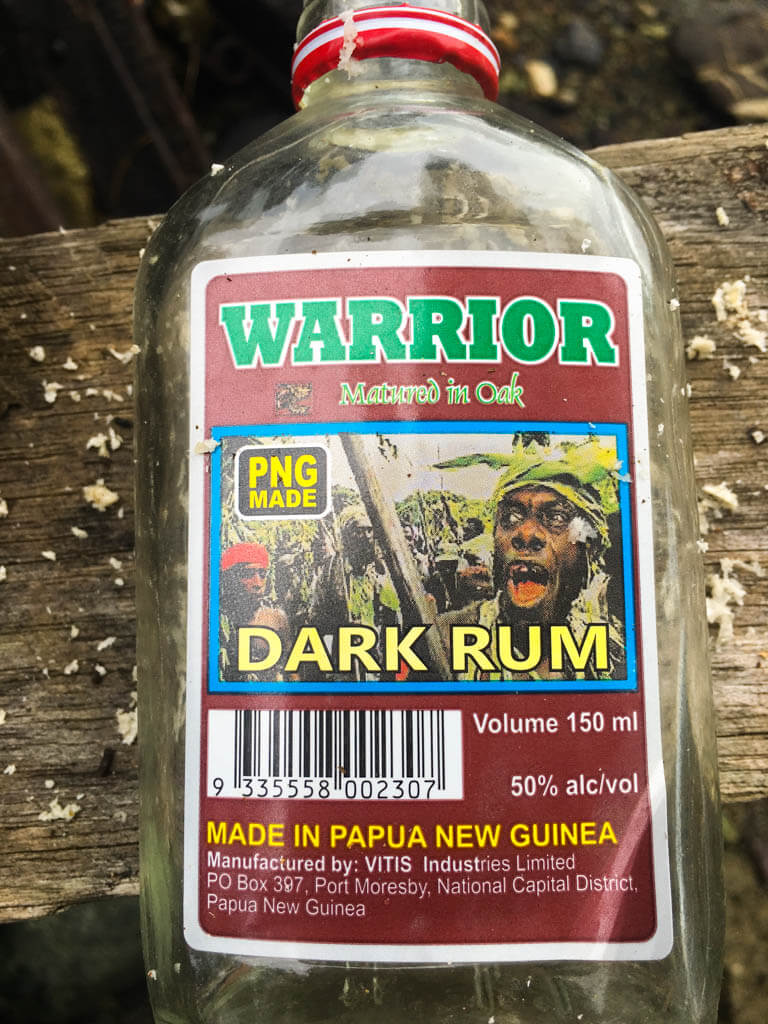
Warrior Dark Rum – PNG’s own.
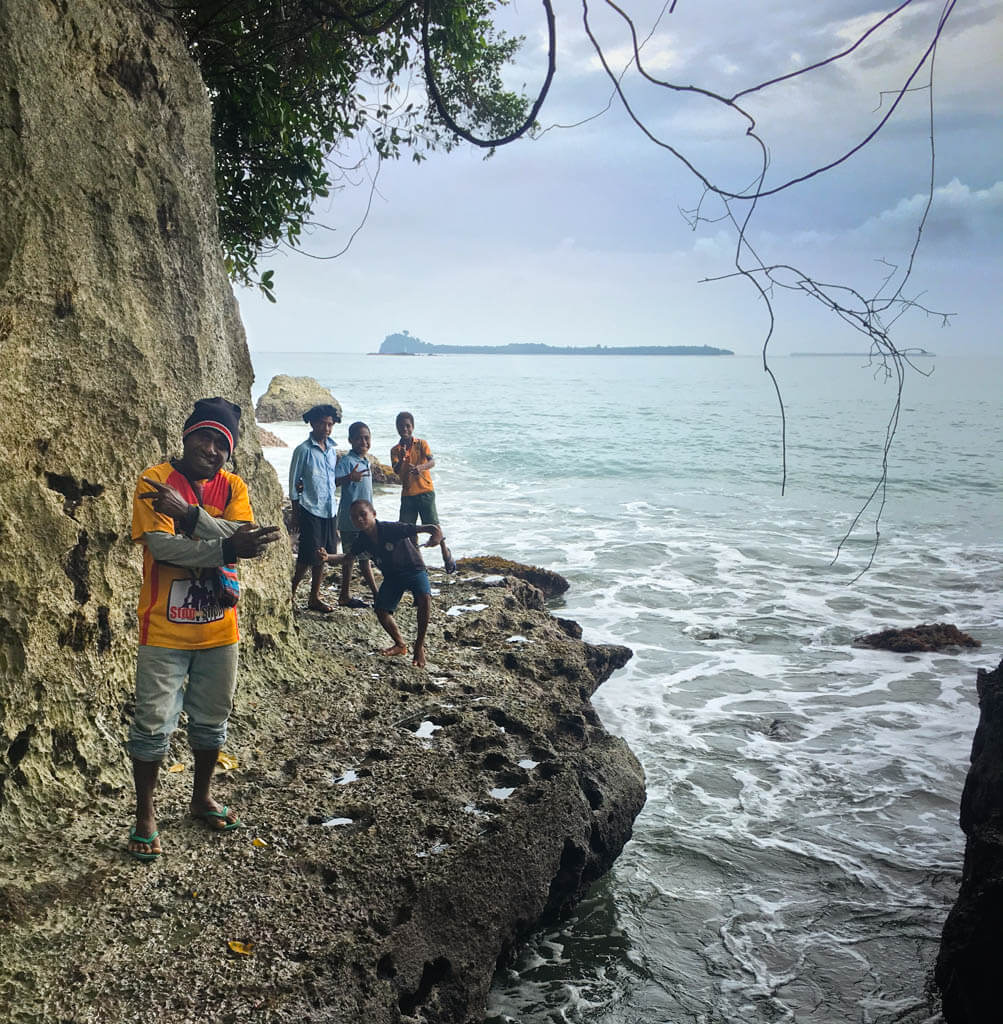
Hanging out with one of my hosts and a group of local kids on the coast.
Vanimo is a very pretty, safe town and a great introduction to PNG. The people are friendly, the beaches are beautiful and, although the main hotels are ridiculously overpriced, there are plenty of alternatives if you look around and don’t mind roughing it a bit. I would highly recommend staying with a local family if you get the opportunity, as they will show you places in the town that you wouldn’t otherwise have found and their hospitality is the best I have experienced anywhere. Aitape is only really interesting if you’re interested in World War Two history, but it is the next stop on the route to Wewak and worth stopping in for a night on your way through.
More Stories from Papua New Guinea
The five weeks I spent in Papua New Guinea were one of the most amazing travel experiences of my life. If you want to read more about it, check out the following article:
Papua New Guinea – Crossing the Indonesia-PNG Land Border
Useful Tips
- Buy some anti-malarial medicine before coming to PNG. I didn’t realise malaria was even an issue until I arrived in West Papua. The pharmacies there didn’t sell it, so I eventually got some in Vanimo. However, even the pharmacist there said it’s not as good as the antimalarials available in western countries. It was very cheap though – 6 kina (€1.58/$1.73) for about a month’s supply!
- Papua New Guineans are very hospitable people and many love to host foreign visitors in their homes, but may think that the conditions are not up to foreign standards. If you don’t mind roughing it a bit, make sure this is clear and you’ll be welcomed with open arms.
- There is a lot of debate and strong opinions online as to whether you should give money to locals hosting you in countries like PNG. In the end, it’s your choice. Personally, I gave a monetary gift to some of my hosts, especially the ones who were obviously very poor. Some who appeared quite rich by PNG standards I thought were more likely to be offended than thankful, so I refrained. One host, who was not rich, refused my offer even when I tried to insist, although I don’t think he was offended. Others accepted gratefully.
- There are three major mobile phone companies in PNG. Telekom has the fastest data speeds, with a 4G network, but has no signal outside of the major cities and even in Wewak and Aitape it didn’t work in all parts of the town. Digicel has the largest network and works in most places, including some Sepik villages, such as Pagwi and Ambunti, but is also more expensive. Bmobile apparently has cheaper data rates. I didn’t use it personally, but a friend who did was pleased with the coverage, with Internet even in the Morobe highlands. However, I’m not sure whether it works widely in the Sepik region. Overall, I would recommend Digicel as the most reliable option, even though it’s a bit more expensive.
- While there is technically a road from Vanimo to Aitape, it is impassable due to a collapsed bridge and lack of maintenance, so the only way to travel between the two is by boat. Banana (speed) boats depart in the morning from Vanimo. The sea is generally calm in the morning and the journey takes 3-5 hours depending on conditions, so it’s best to leave as early as possible. The skipper who took me to Narimo told me that it’s quite common for boats to sink along the route, so it’s best to look for an older skipper, as they’re more experienced and leave as early as possible before the sea becomes rough in the afternoon.
- Some articles online say that it’s possible to take the boat from Vanimo to Aitape and then a PMV from Aitape to Wewak in one day. If you leave really early and are lucky with the timings, this might be possible, but I heard far more stories of travellers getting stuck in Aitape overnight, so don’t count on this.

Hello, friend! Thank you for your post. Please tell me when did you visit PNG and how much did you pay for a boat from Vanimo to Aitape? Please DM to my mail.